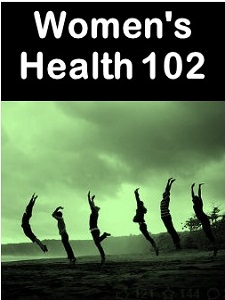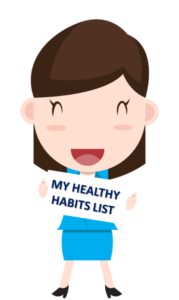Women’s Health 102-Women’s Key Health Issues
TypeOnline Course
Certificate% of quiz marks
Price$27.00

Women’s Health 102: Women’s Key Health Issues-Dealing with health issues that mainly affect women
It’s not easy being a woman. There are several health issues that affect only women which can affect their overall health, quality of life, and length of life if they are not pro-active about their health. Women are living longer than ever before, with the average life expectancy for women in the US about 86 years of age. But it isn’t just about how long you can live, but how long you can stay fit and healthy, so you can enjoy a high quality of life, mobility, and independence.
In this course, we will look at more thing women need to know about their health, and in particular, at some of the main health issues that women need to be aware of as they age.
TO REGISTER:
To start studying this course, click on the button on the right, BUY NOW, to pay for the course. You will be asked to create a user name and password for this site. Once you have set up your free account, you can buy any course on the site. Pay via PayPal or any credit card.
Once you have paid, return to this course page. Instead of the BUY NOW button, you will see a “Start the Course” button instead. Click on it to start studying now.
Note: You may have to REFRESH the page for the button to update.
Navigate though the course through hitting the buttons at the bottom of each lesson to move forward, or use the clickable table of contents that will appear once you start the course to move up and down to the different sections if you wish.
Section 1Introduction
Lecture 1IntroductionFree Preview
 Your body, your health
Your body, your health
The old phrase “An ounce of prevention is worth a pound of cure,” refers to smart people being proactive about their health in order to try to prevent serious illness. The first steps are to know what to look out for. As a woman, there are a range of health issues that either affect us only due to our gender, or which are more common in relation to women than to men.
The second step is to listen to your body. You know yourself better than any doctor. Therefore, you are the best person to determine what is ‘normal’ for you. It will also help if you check your family health tree to see if any particular conditions run in the family. By knowing your risk factors, you can take better care of your health.
The body sends signals to us regarding its needs and potential issues. Some of these signals simply guide bodily functions like eating, eliminating (going to the bathroom), and perspiring. Other signals tell us when an action, something in our environment, or something we consumed may cause us harm. Pain, swelling, itching, stomach ache, and headaches let us know when something is wrong with our body.
Women’s bodies experience an additional barrage of signals each month as part of their monthly cycle. Some menstruating women experience significant cramping, fatigue or moodiness in relation to the rise and fall of hormones during their cycle. Typically, these symptoms signal an imbalance in the woman’s hormones which if corrected should alleviate her symptoms.
Women would benefit from learning to interpret their bodies’ signals. By doing so, they can correct health issues by addressing their source.
Unfortunately, our society teaches people to power through discomfort and sometimes even pain or use pharmaceuticals to mask their symptoms. In this course, we will be reviewing some of the main health issues related to women, and how to handle them safely. We will also discuss when it is time to seek additional help.
Let’s get started by meeting the instructors and getting your downloads for the course.
Lecture 2Meet the InstructorsFree Preview
Carolyn Stone is the author of more than 100 health and wellness-related titles.
Ashleen and Alanna Stone are part of a new generation of health writers and bloggers. They are the authors of more than half a dozen health titles.
DISCLAIMER
This course is designed for general advice only. It is not a substitute for medical advice given by a qualified physician with respect to your own individual circumstances. You should never delay in seeking medical attention if you believe you are ill because of anything you might have read in this or any other health-related guide, website and so on.
Lecture 3Course downloads
Section 2Being proactive about your health
Lecture 4Lesson 1
Lecture 5Lesson 2
Lecture 6Lesson 3
Lecture 7Lesson 4
Lecture 8Lesson 5
Lecture 9Lesson 6
Lecture 10Lesson 7
Lecture 11Lesson 8
Lecture 12Lesson 9
Section 3Your hormones, your health
Lecture 13Lesson 1
Lecture 14Lesson 2
Lecture 15Lesson 3
Lecture 16Lesson 4
Section 4Thyroid health
Lecture 17Lesson 1
Lecture 18Lesson 2
Section 5Nutrition, weight, eating habits and diabetes
Lecture 19Lesson 1
Lecture 20Lesson 2
Lecture 21Lesson 3
Lecture 22Lesson 4
Lecture 23Lesson 5
Lecture 24Lesson 6
Lecture 25Lesson 8
Lecture 26Lesson 9
Lecture 27Lesson 10
Lecture 28Lesson 11
Lecture 29Lesson 12
Lecture 30Lesson 13
Lecture 31Lesson 14
Lecture 32Lesson 15
Lecture 33Lesson 16
Section 6Dealing with cellulite
Lecture 34Lesson 1
Section 7Urinary Tract Health
Lecture 35Lesson 1
Lecture 36Lesson 2
Lecture 37Lesson 3
Section 8Women and Arthritis
Lecture 38Lesson 1
Lecture 39Lesson 2
Section 9Pregnancy
Lecture 40Lesson 1
Lecture 41Lesson 2
Lecture 42Lesson 3
Lecture 43Lesson 4
Lecture 44Lesson 5
Lecture 45Lesson 6
Lecture 46Lesson 7
Lecture 47Lesson 8
Lecture 48Lesson
Lecture 49Lesson 10
Section 10Child Birth and Postpartum Issues
Lecture 50Lesson 1
Lecture 51Lesson 2
Lecture 52Lesson 3
Lecture 53Lesson 4
Lecture 54Lesson 5
Lecture 55Lesson 6
Lecture 56Lesson 7
Lecture 57Lesson 8
Lecture 58Lesson 9
Lecture 59Lesson 10
Lecture 60Lesson 11
Lecture 61Lesson 12
Lecture 62Lesson 13
Lecture 63Lesson 14
Lecture 64Lesson 15
Lecture 65Lesson 16
Lecture 66Lesson 17
Lecture 67Lesson 18
Lecture 68Lesson 19
Lecture 69Lesson 20
Lecture 70Lesson 21
Lecture 71Lesson 22
Lecture 72Lesson 23
Lecture 73Lesson 24
Lecture 74Lesson 25
Lecture 75Conclusion to this Section
Section 11Yeast Infections (Candida)
Lecture 76Lesson 1
Lecture 77Lesson 2
Section 12Sexual health
Lecture 78Lesson 1
Lecture 79Lesson 2
Section 13Perimenopause
Lecture 80Lesson 1
Lecture 81Lesson 2
Lecture 82Lesson 3
Lecture 83Lesson 4
Lecture 84Lesson 5
Lecture 85Lesson 6
Lecture 86Lesson 7
Lecture 87Lesson 8
Lecture 88Lesson 9
Lecture 89Lesson 10
Section 14Menopause
Lecture 90Lesson 1
Lecture 91Lesson 2
Lecture 92Lesson 3
Lecture 93Lesson 4
Lecture 94Lesson 5
Lecture 95Lesson 6
Lecture 96Lesson 7
Lecture 97Lesson 8
Lecture 98Lesson 9
Section 15Breast Cancer Basics
Lecture 99Lesson 1
Lecture 100Lesson 2
Lecture 101Lesson 3
Lecture 102Lesson 4
Section 16Heart Health Essentials
Lecture 103Lesson 1
Lecture 104Lesson 2
Lecture 105Lesson 3
Lecture 106Lesson 4
Lecture 107Lesson 5
Lecture 108Lesson 6
Section 17High Blood Pressure
Lecture 109Lesson 1
Lecture 110Lesson 2
Lecture 111Lesson 3
Lecture 112Lesson 4
Lecture 113Lesson 5
Lecture 114Lesson 6
Lecture 115Lesson 7
Section 18Autoimmune Disorders
Lecture 116Lesson 1
Lecture 117Lesson 2
Lecture 118Lesson 3
Lecture 119Lesson 4
Lecture 120Lesson 5
Lecture 121Lesson 6
Section 19Osteoporosis
Lecture 122Lesson 1
Lecture 123Lesson 2
Lecture 124Lesson 3
Section 20Lifestyle-related health Issues
Lecture 125Lesson 1
Lecture 126Lesson 2
Lecture 127Lesson 3
Lecture 128Lesson 4
Lecture 129Lesson 5
Lecture 130Lesson 6
Lecture 131Lesson 7
Lecture 132Lesson 8
Lecture 133Lesson 9
Lecture 134Lesson 10
Lecture 135Lesson 11
Lecture 136Lesson 12
Section 21Colorectal Cancer
Lecture 137Lesson 1
Lecture 138Lesson 2
Section 22Depression in Women
Lecture 139Lesson 1
Lecture 140Lesson 2
Lecture 141Lesson 3
Lecture 142Lesson 4
Lecture 143Lesson 5
Lecture 144Lesson 6
Lecture 145Lesson 7
Lecture 146Lesson 8
Lecture 147Lesson 9
Lecture 148Lesson 10
Lecture 149Lesson 11
Section 23Fatigue
Lecture 150Lesson 1
Lecture 151Lesson 2
Lecture 152Lesson 3
Section 24Stress
Lecture 153Lesson 1
Lecture 154Lesson 2
Section 25Natural Pain Relief
Lecture 155Lesson 1
Lecture 156Lesson 2
Lecture 157Lesson 3
Lecture 158Lesson 4
Section 26Maintaining Fitness
Lecture 159Lesson 1
Lecture 160Lesson 2
Lecture 161Lesson 3
Lecture 162Lesson 4
Lecture 163Lesson 5
Lecture 164Lesson 6
Section 27A Holistic Approach to Health
Lecture 165Lesson 1
Lecture 166Lesson 2
Section 28Videos
Lecture 167Video 1
Lecture 168Video 2
Lecture 169Video 3
Lecture 170Video 4
Lecture 171Video 5
Lecture 172Video 6
Lecture 173Video 7
Lecture 174Video 8
Lecture 175Video 9
Lecture 176Video 10
Section 29Conclusion
Lecture 177Lesson 1
Final Quiz



